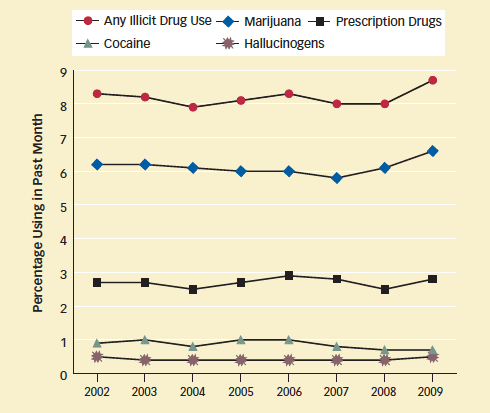Illicit drug use in the United States has risen to its highest level in 8 years, according to the 2009 National Survey on Drug Use and Health (NSDUH). Last year, 8.7 percent of Americans aged 12 and older—an estimated 21.8 million people—said they used illicit drugs in the month prior to the survey, which represents a 9 percent increase over the 2008 rate.
The rise was driven largely by an increase in the use of marijuana, which rose to 6.6 percent in 2009 after holding steady at around 6 percent since 2002. The increase was particularly high among youth aged 12 to 17 and young adults aged 18 to 25. Marijuana is the most commonly used illicit drug; about three-quarters of those who report illicit drug use cite marijuana abuse.
"These results are a wake-up call to the Nation," said Ms. Pamela S. Hyde, administrator of the Substance Abuse and Mental Health Services Administration (SAMHSA), at a press conference held September 16 to announce the findings. "Our strategies of the past appear to have stalled with 'Generation Next.' Parents and caregivers, teachers, coaches, and faith and community leaders must find credible new ways to communicate with our youth about the dangers of substance abuse."
Mr. Gil Kerlikowske, director of the White House Office of National Drug Control Policy, speculated at the press conference that daily coverage in the media of efforts to change state laws to allow the sale of "medical marijuana" and policy debates over legalization of the drug could be contributing to the notion that marijuana is benign.
Changes in state policies and the widening availability of medical marijuana are consistent with the shift in attitudes evident in the survey, says Dr. Wilson Compton, director of NIDA's Division of Epidemiology, Services and Prevention Research. "However, we can't tell which comes first," he says. "Do the changes in perceived risk lead to changes in laws and regulations, or do these policy changes lead to a shift in attitudes?"
Dr. Compton says the rise in drug abuse also corresponds with a decrease in prevention messages targeting youth, as well as a weakening perception among young people that drugs are harmful. "We need to redouble our prevention efforts in families, schools, and communities," he says.
The increase in marijuana use was foreshadowed in survey results released late last year. Both the 2008 NSDUH survey and the 2009 NIDA-sponsored Monitoring the Future survey, which covers students in the 8th, 10th and 12th grades, indicated that the decline in marijuana use over the past decade had begun to reverse. In the past few years, a growing percentage of youth who responded to the two surveys said they did not believe that regular use of the drug was very harmful.
Prescriptions, Meth, and Ecstasy on the Rise
Abuse of prescription drugs and the less frequently used methamphetamine and ecstasy also saw increases. Nonmedical use of prescription drugs rose 12 percent, from 2.5 percent in 2008 to 2.8 percent in 2009. Abuse of methamphetamine rose from 0.1 percent to 0.2 percent, and ecstasy from 0.2 percent to 0.3 percent.
 Rise in Marijuana Use Drives Upswing: Marijuana is the most commonly used illicit drug, with 16.7 million people aged 12 and older reporting past-month use in 2009. A 6.6 percent increase in usage—the highest in 8 years—drove up overall illicit drug use.
Rise in Marijuana Use Drives Upswing: Marijuana is the most commonly used illicit drug, with 16.7 million people aged 12 and older reporting past-month use in 2009. A 6.6 percent increase in usage—the highest in 8 years—drove up overall illicit drug use.The 2009 survey also found that:
- Drug abuse among those aged 50 to 59 doubled to 6.2 percent from 2.7 percent in 2002. This trend reflects the entry into this age bracket of increasing numbers of baby boomers, who have a higher rate of illicit drug use than older cohorts.
- Only about 11 percent of those who need treatment for drug or alcohol abuse received therapy in a specialty facility. Previous years had shown a similar disparity.
The annual NSDUH survey is sponsored by SAMHSA. The 2009 results are based on responses from 68,700 civilians nationwide who do not live in institutions. The report is available online at www.samhsa.gov/data/population-data-nsduh.
Source
Substance Abuse and Mental Health Services Administration, 2010. Results from the 2009 National Survey on Drug Use and Health: Volume I. Summary of National Findings (Office of Applied Studies, NSDUH Series H-38A, HHS Publication No. SMA 10-4586). Rockville, MD. [Full Text]
